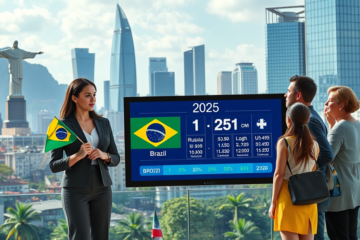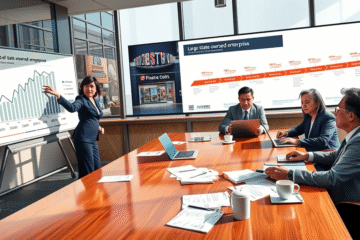Impact of Immigration Policies on the Lives of Brazilians
Immigration Policies play a crucial role in the lives of Brazilians living in the United States, affecting both their opportunities and their daily concerns.
This article will explore how the country's salary and quality of life attract many, despite the challenges they face, including the insecurity generated by the anti-immigrant climate.
Additionally, we will address the initial difficulties in obtaining an EB-3 visa, labor shortages in essential sectors, and the growing pressure on immigrants, reflecting on the 'American dream' and its new complexities.
Current Context of Immigration Policies
The recent ones immigration policies of the United States have directly impacted the life of Brazilians in the United States.
Many immigrants face significant challenges due to the current political climate read more about changes to immigration laws in Latin America.
Concerns about permanence and the search for stability are constant, especially with the instability associated with the anti-immigration climate.
This instability affects even those seeking legality through specific visas such as EB-3.
Furthermore, the labor shortage in key sectors potentially intensifies the problem as it can lead to inflation and rising costs.
However, many Brazilians still venture into the pursuit of the “American dream,” attracted by better economic opportunities, despite the growing complexities. Understand how restrictions affect migration dynamics.
At the same time, the US government is implementing restrictive measures that slow down the naturalization process, which will have a long-term impact on the job market. in the USA.
Thus, the current scenario presents significant challenges for the Brazilian community, requiring constant adaptation to navigate the migration policies.
Daily Experiences of Brazilians
The daily experiences of Brazilians in the United States reveal a multifaceted reality, in which economic benefits and insecurities coexist.
Despite opportunities for better pay and a better quality of life, many immigrants face constant concerns about their future and the instability of immigration policies.
This duality is reflected in the daily routine, where each achievement is accompanied by challenges that require resilience and adaptability.
Compensation and Quality of Life
Many Brazilian immigrants in the United States realize that wages and lifestyle compensate for the barriers faced.
The prospect of economic gains and well-being becomes even more attractive when compared to the situation in Brazil.
Even when faced with legal challenges, such as obtaining an EB-3 visa, and cultural adversities, Brazilian immigrants see the opportunities offered as a chance to significantly improve their living conditions.
- Starting salary higher than the Brazilian one
- Affordable consumption costs in some regions
- Possibility of saving in dollars
A key factor in this decision is the possibility of sending part of the income to family members in Brazil, alleviating the economic pressure on these households.
According to one report on migration to rich countries, immigrants have access to significantly higher incomes and a better quality of life.
“Migration to rich countries can provide incomes up to 15 times higher,” highlights the aforementioned report.
This reality, combined with the chance of integration into welcoming communities, largely compensates for the emotional dilemmas and uncertainty about the future, keeping the American dream despite the current complexities.
Feelings of Insecurity and Anti-Immigration Climate
The persistent perception of a anti-immigration climate in the United States has provoked a growing feeling of insecurity among Brazilians residing in the country.
The adoption of strict immigration policies and the rise of anti-immigrant political rhetoric contribute to the formation of a hostile environment.
These measures not only affect the permanence of immigrants, but also intensify the future concerns about possibilities of deportation.
As reported by Boca do Povo News, many Brazilians fear for regulatory stability and abrupt changes in immigration policies.
Furthermore, vulnerability to discriminatory practices and social exclusion in everyday life are real concerns.
“Living in constant insecurity has become part of our lives,” says an anonymous Brazilian immigrant, reflecting the apprehension that permeates the community.
The challenges faced increase psychological pressure and lead to changes in career plans and even in the lifestyle of Brazilians.
The promise of better financial conditions is overshadowed by the uncertainty that dominates the future.
This distressing situation reinforces the desire of many to seek a more welcoming environment, where they can build a future without the fear of reprisals.
Legal Pathways: Focus on the EB-3 Visa
The search for EB-3 visa It is an important avenue for Brazilians who wish to legally reside in the United States, covering both skilled and unskilled workers.
However, this process is not without challenges.
Strict requirements and extended deadlines add complexity to the process.
To apply for the visa, it is essential to have a job offer from an American employer willing to sponsor the visa, in addition to proving required qualifications, such as previous professional experience.
EB-3 visa procedures can be extended due to several formal steps.
The following table illustrates some of the essential steps:
| Step | Document | Estimated deadline |
|---|---|---|
| Request | Form I-140 | 6-10 months |
| Certification | Labor Certification | 6-8 months |
| Approval | USCIS Review | 4-6 months |
Form I-140 begins the formal process with the Immigration Department, while the Labor Certification, coordinated by the employer, validates the job offer.
After these steps, review and approval by USCIS ensures that all immigration criteria have been met.
To the initial difficulties include identifying a sponsoring employer, coordinating the necessary documents, and understanding the legal steps, which may vary depending on the candidate's situation.
Improve these areas is essential to accelerate the realization of the American dream.
Labor Shortage and Economic Consequences
A labor shortage in the United States is a phenomenon that intensifies the inflation and aggravates the pressure on immigrants, especially within the Brazilian community.
As noted by Lucas Costa, a renowned fictional economist, “the shortage of skilled workers in essential sectors like healthcare and technology not only increases costs but also fuels debates about the need to reform immigration policies.”
This lack of professionals creates a scenario where wages are naturally high due to the high demand for labor, but paradoxically, it generates an increase in the prices of goods and services, which is a significant concern for Brazilians trying to achieve their dreams. American standard of living.
Furthermore, according to fictional expert Carla Silva, “pressure on immigrants is intensifying in an attempt to balance the labor supply, but the social cost is immeasurable.”
Immigrants face an environment of uncertainty, compounded by an often unfavorable political climate, while the economy tries to adjust to these failures.
Even with the worker shortage as a backdrop, visa barriers like EB-3 continue to pose a significant obstacle for many seeking a better life in the U.S., creating a cycle where systemic inefficiency persists.
The 'American Dream' in Transformation
The trajectory of Brazilians in search of American dream shows a mix of determination and adaptation.
Despite new and more sophisticated complexities, such as the embeddedness of immigration policies and the insecurity generated by anti-immigration rhetoric, hope persists.
Brazilians, in pursuing a better life in the United States, face contemporary challenges that defy your initial expectations.
However, quality of life and opportunities are markers that continue to attract many, offsetting the obstacles faced.
As highlighted by characters like Tereza Lee and Felipe Matos, who lived as illegal immigrants, the reality of American dream It may be bitter, but the potential for growth often speaks louder.
A complete analysis of these motivations can be found in dedicated articles, such as [Towards the American Dream – Megacurioso](https://www.megacurioso.com.br/estilo-de-vida/rumo-ao-sonho-americano-a-jornada-dos-brasileiros-nos-eua) and [Motivation and Challenges of Brazilians – Migalhas](https://www.migalhas.com.br/depeso/408624/motivacao-e-desafios-dos-brasileiros-que-buscam-a-vida-nos-eua).
Challenges are doors to new opportunities
, and Brazilians, with resilience, continue to move towards a promising future.
This search reiterates the idea that, given the new complexities, they reconfigure themselves, proving that the American dream still pulsates, but with new tones.
In short, immigration policies shape the experience of Brazilians in the US, creating a scenario full of opportunities and challenges.
The 'American dream' remains alive, but demands resilience in the face of current adversities.



0 Comments